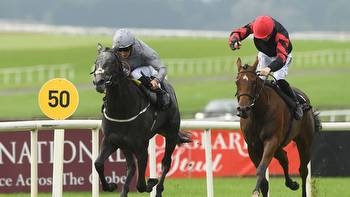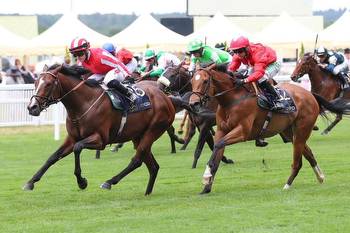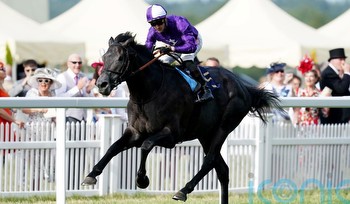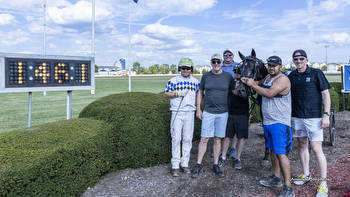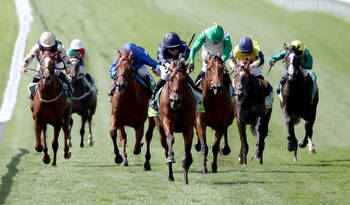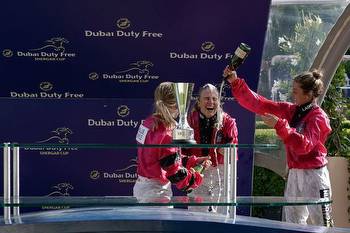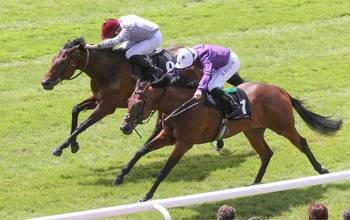Timefigure analysis for Prix Jacques Le Marois, Shergar Cup, Newmarket and the Curragh

Usually, one of the pleasures of spending several weeks in Northern France in the summer is the chance to get around the varied racetracks and experience some of the different disciplines that aren’t always available or well publicised back home.
That hasn’t been the case this summer unfortunately in and amongst working as bad weather has limited opportunities to the extent that when the sun finally did come out on Sunday at Abbeville, so many people turned out that parking was very tight and the food ran out before the second of eight scheduled trotting races had been completed. And with some of the starts more chaotic than the indefensible Brighton fog-up the other day, I gave up the ghost after five races. Hoping for better at Deauville this weekend!
One of the presumptions still widely held about racing in France is that most races are slowly run. That might have been nearer the truth back in the day when the trainers and jockeys were more old school, and the French Calendar consisted largely of conditions races, but things have changed a lot over the years as all-weather tracks have taken hold and many more handicaps have been introduced into the programme to boost opportunities for both the punter and competitor.
The abundance of French tracking data available from even lowly French tracks on the France Galop website makes this abundantly clear, though you have to be careful interpreting data on days when the rail is out but additional yardage (or should that be metreage?) isn’t added to the advertised race distance, and certainly in the case of the Prix Jacques Le Marois at Deauville, which is run over a straight 1600m and therefore immune to rail movements, what you saw was pretty much what you got.
While the race might have lacked an outstanding miler, it contained enough decent horses to think the verdict was going to be hard won whichever horse emerged on top and with front-running Big Rock in the line-up, dropping back to a mile after his fine second to Ace Impact in the Prix du Jockey-Club, as well as the often pace-forcing Queen Anne winner Triple Time the race ended up being as well run as it looked beforehand.
Using a universal finishing speed model adapted for results over the past few years at Deauville since tracking data has been made available, the result looks a very fair one. Big Rock set quick fractions in front and stuck on very well for second but wasn’t able to run the finish out of Inspiral who put her heavy-ground Sussex Stakes flop behind her by running the sections between 600m out and 400m, and 400m out and 200m out, faster than anything else, and failed by only 0.04 seconds to run the fastest final 200m as well, readily reversing Queen Anne form with Triple Time when she was set too much to do.
The sectionals don’t really convey it, but the 2022 Grand Prix de Paris winner Onesto ran a cracker on his reappearance over an inadequate trip, almost the last off the bridle but not having the pace to challenge. All the same, the day belonged to Frankie Dettori who (along with the Gosden yard) was winning the race for a remarkable fourth year in succession.
Dettori might have been the star of the show at what is supposedly his last Deauville summer but the previous day he’d failed as usual to make much impact at the Shergar Cup. For all Ascot may say otherwise after attracting a crowd of nearly 25,000, team competitions have still to gain traction with the more educated racing public for all their own event is far more palatable than the heavily fabricated Racing League.
All the same, it seems to me the Shergar Cup needs some reinvigoration. The format has stood the test of time and is easy for newcomers to racing to understand and follow, but too many of the jockeys earn their corn here and the competition isn’t as aspirational as it once was when it was a magnet for some of the best jockeys in the world.
Aiming for the best again while restricting the maximum age of the riders to 35 (HINT to Ascot: Irish superstar Rachael Blackmore turns 35 next July) or even 30 isn’t an overly ambitious and would engage with a younger and newer crowd.
Whatever path they choose, the latest Shergar Cup was another showcase for the emerging Saffie Osborne who has now ridden 44 domestic winners since she lost her claim. According to my research it took her 415 rides to do that whereas it took fellow winning Ladies Team members Hayley Turner 781 rides (albeit at a time when there was still some lingering resistance to female riders) and Hollie Doyle 475 rides.
I’m sure the future is bright for the well-connected Osborne but the same might have been said several years ago about Josephine Gordon, who not long ago turned down a Shergar Cup invite because of Group-race commitments the same day. She took only 372 rides to reach 44 winners after burning through her claim yet in the same period as Osborne has ridden those 44 winners has had just 173 rides despite hitting a virtually identical strike rate (and better than Turner’s) while riding horses with an average starting price 9 pts bigger.
With Gordon at Haydock for just one ride, Osborne conjured a career-best 105 performance on the clock from Ebor possible Scampi in the mile-and-a-half handicap as part of her contribution to the Ladies team running out narrow winners from the Rest Of The World. However, had Matthew Chadwick not had Struth quite so far back in the penultimate handicap (his horse ran each of the last five furlongs faster than the Hollie Doyle-ridden winner Regal Empire) then the result would have gone the other way. The ficklest of games!
You often read or hear it said that whenever horses are separated by a neck and a nose in a three-way finish the form can’t be up to much, especially when two of the horses involved start at double figure prices, but I’d bet the form of the two-year-old novice won by Jubilee Walk at Salisbury last week (race replay below) is strong form for its level with the first three finishing five lengths clear.
Unlimited race replays of all UK & Irish racing
Access to exclusive features all for FREE - No monthly subscription fee
Log in with your existing Sporting Life, Sky Bet, or Sky Games account. If you don't have any of those, it's completely FREE to register!
Prior ratings standards used by Timeform to inform handicappers of a range of ratings that would normally be associated with a race of that type given the margins between the runners at the finish suggested a figure between 78 and 83. That sort of assessment would have had fourth-placed Boyfriend (who had already run to a 85, later revised downwards to 83) and fifth-placed Odonnell’s Orchard (86, later revised to 84) running well below form, but in instances like these the clock can be the best guide of all, and with three other races over the same six-furlong distance on the same card to compare it with, as well as three other races at a mile or shorter, a settled-on timefigure of 94 for the winner was still a couple short of what I could have returned.
Cajetan and Zabriskie Point, the others in the first three, the latter carrying a 7lb penalty after a Leicester debut success, can go in the proverbial notebook as well Jubilee Walk.
A couple of other two-year-olds you might want to add are Mortlake and Kingdom Of Riches who both scored at Leicester on Sunday as part of a Ralph Beckett three-timer. Mortlake recorded the faster timefigure of the pair, 90 as opposed to 86, and ran a 34.1 final three furlongs according to Course Track, easily the fastest on the day, and very smart 11.56 in the final furlong as he started to draw well clear. All that together adds up to an overall timerating in the low 100s and he’s likely a Group 3 performer at least in the making.
Much as at Salisbury, the Curragh’s Saturday card thankfully had all its races contested between five furlongs and a mile which makes analysis of the winning times more straightforward than is often the case there when two-mile races might need to be compared with five-furlong sprints.
The feature event was the Group One Keeneland Phoenix Stakes which along with the Phoenix Sprint was one of two Group races run over six furlongs. A four-length win for Bucanero Fuerte might have been a second successive wide-margin win in the race following Little Big Bear’s seven-length demolition but a winning time of 1m 12.53 translates only translates into a timefigure of 102, compared to the 98 Cherry Blossom posted in the two-year-old maiden or Moss Tucker recorded in the Phoenix Sprint.
What the sectionals taken manually by Timeform in each of those races suggest is that Bucanero Fuerte went hard from the front along with his supposed pacemaker Launch, over 0.4 seconds or getting on for three lengths quicker to halfway than any of the other six-furlong winners, yet despite that still had too much speed and stamina for any of his rivals, among whom only fourth-placed Unquestionable (beaten a short head in the Railway Stakes when the pair were well clear) really had any sort of excuse having got upset in the stalls and reportedly lost a front shoe.
Paced more evenly, Bucanero Fuerte would probably have returned an even higher timefigure but even so Cherry Blossom’s finishing effort to get within 0.08 seconds of his winning time despite running the first three furlongs 0.61 seconds slower is testament to her own Group-race potential. A final-three furlong time of 34.71 wasn’t the fastest of the six-furlong races – that honour went to Moss Tucker - but given she’s a two-year-old filly who was carrying only 5lb less than the five-year-old when weight-for-age suggests she should be receiving considerably more, then perhaps it’s no surprise than the Lowther Stakes is under consideration.
If there was another potential pattern performer on show on the day, then it was surely Diego Velazquez in the opening maiden. A 57 timefigure wouldn’t lead you to that conclusion by itself, but a 2,400,000-guinea purchase price as well as a starting price of 2/5 might besides which his 34.13 finishing split was the second fastest winning sectional of the day, behind only five-furlong winner Little Queenie and faster even than Moss Tucker.
Across at Newmarket, Fallen Angel was the winner of the Group 3 Sweet Solera Stakes, sponsored by Aspall Cyder. Locking horns again with the Albany third Soprano who had finished one place behind her when the pair had been second and third in the Star Stakes at Sandown on their latest outings, Fallen Angel ran out an emphatic winner in a 100 timefigure which is well up to scratch historically.
The only other pattern race on a quiet domestic weekend was the Rose Of Lancaster Stakes at Haydock which went to the reformed (or quirky, depending on your viewpoint) Al Aasy. Now the winner of three of his last four races, a 115 timefigure is one finally up there with the best of his performances on form and in this sort of mood there might be even more to come back at a mile and a half.
- Racecards
- Fast results
- Full results and free video replays
- Horse racing news
- Horse racing tips
- Horse racing features
- Download our free iOS and Android app
- Football and other sports tips
- Podcasts and video content
Safer gambling
We are committed in our support of safer gambling. Recommended bets are advised to over-18s and we strongly encourage readers to wager only what they can afford to lose.
If you are concerned about your gambling, please call the National Gambling Helpline / GamCareon 0808 8020 133.
Further support and information can be found at begambleaware.org and gamblingtherapy.org








